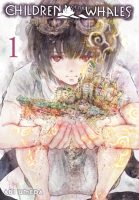Children of the Whales suffers from the same problem as many prestige television shows: it boasts a thought-provoking premise, compelling lead characters, and sophisticated visuals, but is such a relentlessly downbeat experience that you’d be forgiven for abandoning ship after a few chapters.
The story unfolds aboard the Mud Whale, a sentient vessel. Its 513 inhabitants have been exiled from their homeland for over 90 years, drifting across a vast ocean of sand punctuated only by the occasional island or abandoned boat. Fourteen-year-old Chakuro is the community’s archivist, tasked with recording births and deaths, strange encounters, and changes in the Mud Whale’s leadership, events he catalogs with almost fanatical devotion. Making his job more bittersweet is the discrepancy between the “marked” residents, whose ability to wield magic (or “thymia,” in the series’ parlance) dooms them to a short lifespan, and the unmarked residents, whose normal lifespans have forced them into the role of caretakers and governors.
To stave off despair, the Mud Whale’s residents eschew emotional display — a point reinforced in the earliest pages of volume one, when Chakuro sheds a tear at a 29-year-old woman’s funeral. Immediately, his peers enjoin him not to weep, lest “the souls at the bottom of the sea cry out for you.” It’s a simple but effective scene, one that reminds us that the Mud Whale’s inhabitants are caught between the real prospect of extinction and the uncertain possibility of survival; only their fierce commitment to living in the present moment preserves their tenuous existence.
While scavenging for supplies on a seemingly deserted island, Chakuro stumbles across a blank-faced girl about his own age. She attacks him with swords and sorcery, only to collapse, unconscious, from the effort of casting a spell. Chakuro is frightened but intrigued, and brings Lykos back to the Mud Whale where he learns her true identity: she’s an apatheia, an emotionless soldier. “Emotions will destroy the world,” she informs Chakuro. “The outside world you want to know so badly about is ruled by people deficient in feeling, using apatheias who have no heart to fight a war without end.”
 The next major plot development — a surprise attack — delivers the series’ first truly grim moments, as the Mud Whale’s inhabitants are beaten, impaled, and gunned down by unknown assailants. Though Chakuro and Lykos have been fleshed out enough to earn the reader’s pity, the sheer size of the cast and the suddenness of the ambush blunt the impact of the carnage; we can see that Chakuro is devastated by the loss of his childhood friend Sami, but Sami is such a stock character — innocent, impetuous, infatuated with Chakuro — that her gruesome death registers as a manipulative attempt to illustrate the truth of Lykos’ earlier comments about the outside world. That same kind of heavy-handed editorializing extends to the villains’ physical appearance as well. They look like Juggalos in chain mail, sporting maniacal grins that scream, “Sadists ahoy!”, a point underscored in the gleeful way in which they violate corpses and taunt sobbing victims.
The next major plot development — a surprise attack — delivers the series’ first truly grim moments, as the Mud Whale’s inhabitants are beaten, impaled, and gunned down by unknown assailants. Though Chakuro and Lykos have been fleshed out enough to earn the reader’s pity, the sheer size of the cast and the suddenness of the ambush blunt the impact of the carnage; we can see that Chakuro is devastated by the loss of his childhood friend Sami, but Sami is such a stock character — innocent, impetuous, infatuated with Chakuro — that her gruesome death registers as a manipulative attempt to illustrate the truth of Lykos’ earlier comments about the outside world. That same kind of heavy-handed editorializing extends to the villains’ physical appearance as well. They look like Juggalos in chain mail, sporting maniacal grins that scream, “Sadists ahoy!”, a point underscored in the gleeful way in which they violate corpses and taunt sobbing victims.
The most frustrating thing about these frenetic chapters is that they seem fundamentally at odds with the deliberate pacing and meticulous world-building in volume one. In these introductory pages, Umeda maps every nook and cranny of the Mud Whale, creating an environment as imposing and intimate as Hayao Miyazaki’s Laputa. She approaches her character designs with same patience and care, bestowing a semblance of individuality on each resident while establishing their collective identity as a people. Even Chakuro’s frequent voice-overs — presumably read from the Mud Whale’s archives — play an important role in helping us experience time the way the Mud Whale’s residents do; there’s a lyrical quality to Chakuro’s narration that captures the rhythms of their day-to-day existence.
Yet for all Umeda’s world-building skills, Children of the Whales‘ dour tone puts the reader at arm’s length from the characters. Minus the flashes of joy, humor, and warmth that temper Miyazaki’s most downbeat films, Children of the Whales feels more like an episode of The Leftovers or Rectify than Castle in the Sky; it’s so utterly mirthless that it casts a pall over the reader instead of prompting deep thoughts or empathy for the characters. Take my manga, please!
CHILDREN OF THE WHALES, VOLS. 1-2 • BY ABI UMEDA • VIZ • RATED T+ (FOR OLDER TEENS)


